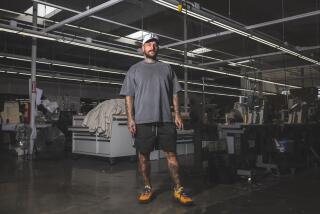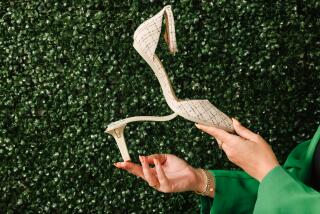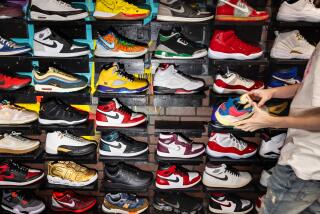GOOD HEALTH MAGAZINE : FITNESS : IF THE SHOE FITS : ATHLETIC-FOOTWEAR DESIGN IS MORE ART THAN SCIENCE, BUT THE GUESSES ARE BECOMING MORE EDUCATED
- Share via
Once upon a time--when life was simple--exercise was pretty generic, and so were your athletic shoes. To unwind, you shot a few hoops by the garage, tossed a softball over at the school or strolled down to your local mailbox. You probably wore a pair of $12 sneakers and never gave them a second thought.
Came the fitness boom and suddenly you learned that your old footwear just couldn’t keep up. Maybe you started running 30 miles a week, practiced an hour of aerobics every few nights or joined a basketball or softball league. Walking, running, tennis, basketball and aerobics each involve different types of movements with their own distinctive patterns of stresses and strains. And so, because your work-outs got serious, you had to get a serious shoe.
In this case, a little consumer knowledge proved rather dangerous. Your need for the “right” shoe caused the shoe industry to make lots of models, not only differentiated by sport but often by the kind or level of activity you were doing in that sport. Runners had a choice of models made for sprints or ultramarathons, trails or road running, while aerobics fanciers could pick between models for high- and low-impact regimens, to name a few.
Currently, walking shoes and basketball sneakers are in, says Thomas B. Doyle, research and information director for the National Sporting Goods Assn. In 1988, while the overall market for sports shoes rose only 7% to nearly $3.8 billion, sales of walking shoes jumped 47%, and high-tech basketball shoe sales grew by 34%.
Today, however, the sports medicine, biomechanics and shoe-manufacturing communities are divided on a number of fronts. In large part, the controversies are due to an overall lack of knowledge on exercise biomechanics and its relationship to sports injury. Shoe design remains more art than science, although the guesses are becoming more educated.
One source of disagreement is the current back-to-basics movement, which is fostering the return of the generic athletic shoe (one that bears little resemblance--in look or price tag--to those $12 sneakers of the past). Part of this movement arises from the growing realization that specializing in a single sport isn’t necessarily healthful, much less fun. “We’ve been looking at the fitness boom for years,” says Tom Clarke, Nike marketing vice president, “and we’ve observed that people are becoming much more inclined to do a different number of activities to be fit.”
However, this trend is also a reflection of the growing confusion over just how injury results from exercise. Here again, a little too much knowledge--in this case, on the part of researchers--has been dangerous. Sure, laboratory techniques have improved markedly and there is a growing body of data that is getting more sophisticated all the time. But are the data reliable? How can you truly gauge the impact of jumping, for instance, if no two jumps are alike? On the other hand, does the very act of gathering data--for instance, instrumenting a subject or asking him to land on a special device that records the force--affect the way a person jumps?
Increasingly, the answer for consumers seems to be: When in doubt, wear what’s most comfortable.
Enter the cross-training shoe. “We were the first company to say that people who are concentrating in any particular sport need to buy a specialized shoe,” says Nike’s Clarke, himself a biomechanics Ph.D. But about two years ago Nike changed gears and premiered the cross trainer, a shoe for everyman, and subsequently turned the market upside down.
The cross trainer is especially targeted toward health club members who enjoy a variety of forms of exercise. “The typical cross-trainer (user) is a person who plays some racquetball, runs two or three times a week, maybe takes an aerobics class or lifts weights,” Clarke says. Yet, he adds, such diverse activity is forcing people to make compromises that could be painful. “You have to be realistic and understand that these people generally don’t buy different shoes for each sport,” he says. “Chances are, they own tennis shoes, which is reasonable for racquetball but not for running.”
The cross trainer combines the cushioning of running shoes with the firm foot support of basketball shoes. According to Clarke, the breakthrough that made the cross trainer possible was the “foot-frame,” an extension of the midsole up the sidewalls (or upper) of the shoe--in effect, providing some of the support of basketball shoes but without their weight or stiffness.
Cross trainers are the most controversial development in the athletic shoe field. They are at best a half-baked compromise, according to La Jolla podiatrist Dr. Joseph Ellis, who happens to consult for Asics-Tiger, one of Nike’s competitors. “The cross trainer is like a leisure suit,” he says, “which is neither for leisure nor a suit.”
Most of the impetus for high-tech athletic shoes came from running, which kicked off the fitness boom in the 1970s. Running remains the best-understood sport, and not only because of its early popularity and longer history of research. Running has also proven the easiest sport to measure in the lab because it is simple and repetitive. The runner moves in only one direction, plants his heel, rolls onto midfoot, then propels off at the toes, repeating the cycle about 500 times each mile.
Poor shock absorption remains the bane of runners. At each heel strike, the foot hits the ground with a force equal to three times the person’s weight. Without adequate cushioning, runners may suffer shin splints, a severe stretching of lower leg muscle; plantar fascia, an inflammation of ligaments fanning out from heel to forefoot, and heel spurs.
To some extent, the foot naturally braces to reduce the shock of heel strike. Rather than hit ground squarely, it bends and rotates a bit. For most people, especially those with flatter feet, the foot tends to roll inward during ground contact, a process called pronation. A certain amount of pronation is fine, but too much of a good thing causes “runners knee,” a sharp pain caused by the twisting and tearing of tendons surrounding the kneecap. This occurs as the knees try vainly to twist in sympathy with the pronating foot.
Therefore, running shoes need to cushion, yet control excess foot movement, which is a bit of a paradox since too much cushioning can accentuate pronation. For that reason, cushioning is generally limited to about an inch of material under the heel and is used in conjunction with a rigid cup, called a heel counter, that confines the heel tissue (which itself provides natural cushioning) during impact.
Cushioning is the area with the greatest variations between brands: For instance, Nike’s air sole features encapsulated gas, while Tiger’s gel sole encapsulates a viscous fluid. Brooks, in turn, has designed the “Hydroflow” system using two chambers of fluid that actually flow in response to the degree of impact upon heel strike.
Most of the features that control pronation are found in the sole. For instance, a wedge of material is generally cut lengthwise down the center axis of the sole to, in effect, cause the foot to “fall” towards center while it is on the ground. Firmer material is used along the inner edge of the sole in the midfoot to further reduce the degree of inward roll.
The flip side of cushioning is resilience, also known as “energy return.” Although you need cushioning in the sole, too much of it can make the shoe feel like a dead weight--the last thing you want to experience when you’re finishing that 10K race in the park. Energy return is the key theme behind Reebok’s latest physics of motion advertising campaign. It’s put there not only to make you run faster but to help prevent injury as well, says Reebok marketing chief Mark Goldston. “Energy return helps keep the foot stable. If you come down with severe impact on the heel and there’s no source of energy return, you could wobble or shimmy.” To get that extra bounce, Reebok places tubes made from Hytrel, a material developed out of the space program.
The jury is still out on just how much resilience is really needed. “I’m not sure you really want energy return,” says Tiger’s Ellis, who claims that too much of a good thing could destroy the foot.
Denver sports podiatrist Dr. Edward Raczka agrees. “We still don’t know about the secondary arthritic changes that could occur over time.” Nike’s Clarke supports the concept, but believes that much of the current advertising is deceptive. “Some new interpretations will make you believe that you will come down on the sole like a trampoline. That’s still pretty hard to achieve with a material that’s only an inch thick with people of 150-200 pounds crashing down on it.”
Many runners whose legs couldn’t take the stress have turned to walking. Sensing an emerging market--one composed of aging, affluent yuppies--the shoe companies have responded in force with yet another new kind of shoe. The question still rages whether we really need specialized shoes for a rather generic, low-stress activity. “We have walking shoes because the consumer wanted them--because it’s hard to say that you have a legitimate category if you don’t have any equipment,” says Athletes Foot shoe testing center director Tom Brunnich, who also covers the industry for Runners World.
“The walking shoe is a fashion look,” claims Ellis. “A lightweight running shoe is adequate for walking. Even a tennis shoe might be adequate.” Not according to Alex Hofsteter, marketing director for Rockport, which practically invented the walking shoe 15 years ago. According to him, when you walk, your heel may hit the ground with only half the force of running, but it is hitting the ground at a more acute angle. Furthermore, he adds, your feet are on the ground longer, meaning you have more of a chance to pronate. That’s almost a nonproblem, counters Converse biomechanics research director Rick Bunch, since the foot is hitting the ground with far less force.
Regardless, Hofsteter adds, running shoes are simply too squishy for walking. At heel strike, they feel like a soft pillow, then they immediately collapse. Therefore, compared to running shoes, Rockports are designed with heavier heel cups, firmer cushioning, and higher arch support for the midfoot during the gait, thereby limiting pronation.
Although walking may be the kindest and gentlest sport to the foot, the court sports, especially basketball, are certainly among the cruelest. “You can understand why basketball players have to be the greatest athletes in the world,” Brunnich says. “They have to jump, be able to move side to side like a tennis player, then turn around and run up and down the court like they’re doing an 800-meter dash.”
The sheer variety of movements makes the court sports very difficult to measure, according to University of Oregon biomechanics professor Dr. Barry Bates. For instance, no two jumps are alike; the combination of forces that result when someone jumps, turns, changes direction, plants the feet or simply lands atop the toes of an opposing player is considerable. To get just a vague idea of the ground impact forces involved, Bates’ lab is dropping people from premeasured heights, a test he concedes does not account for the added stresses due to propulsion.
In basketball, those stresses produce ankle sprains, knee twists, shin splints, fatigue fractures and, of course, toe fractures from collisions under the backboard. Forget about lightweight performance shoes. Although many basketball shoes carry the sleek Michael Jordan look, they are brute-force gear, heavily armored from heel to toe. “If they could put a ski boot on a basketball player, they’d do it,” says Ellis.
For tennis players, the stresses might be more in the head than in the elbow. Still, like their basketball counterparts, tennis players are prone to ankle sprains and knee twists. Compared to their basketball brethren, tennis players run more from side-to-side, stop and start more suddenly, and plant their feet more often. However, they jump less and almost never collide with anyone. Therefore, to keep the foot stable during lateral movement, the upper portions of the shoe are thicker than running models but not as fully armored as those for basketball. For stops and starts, the shoe requires a harder sole with strong traction and forefoot flexibility.
If the state of knowledge about tennis and basketball is primitive, it is practically nonexistent for aerobics. Credit that partly to the newness of the activity but mostly to, again, the great variety of movements. Jumping alone is hard enough to measure, but add to that the endless variation of disco dancing, hops and steps from side to side, and you can understand why aerobics are a scholar’s nightmare.
Although the individual movements in aerobics might not match those of court sports, they are far more frequent, and if you are an instructor who teaches several classes, watch out. According to Penn State University biomechanics researcher Todd Miller, you are three times as likely as your students to get hurt.
Denver sports podiatrist Raczka recommends a shoe with a fairly low heel and a firm upper to keep the foot from wobbling at ground impact and, of course, lots of cushioning. Because aerobics dancers tend to jump off their toes, the forefoot of the shoe must be flexible; yet the rest of the upper must be firm to protect the foot during lateral movements.
But when it comes to selling aerobics shoes, according to Tiger’s Ellis, perhaps the top priority is that they look good. “I was giving a talk at a trade show about a year ago and a woman asked me why we didn’t design a high-tech aerobics shoe,” he says. “We’d stand at our exhibit booth and display one (a high-tech model) that looked ugly, and all we’d hear is, ‘I’d never wear that.’ ” Ellis claims that the shoe companies can’t take aerobics seriously, an argument that Reebok’s Goldston--whose company made its name in aerobics--disagrees with. “High performance and high image don’t have to be separate,” he says. “Look at Porsche 928; just because they make it beautiful doesn’t mean it can’t go 160 m.p.h.”
The question of technology vs. fashion has dogged the sports shoe industry since the fitness boom first made sneakers big business. The boom, and the technology, started with running shoes in the ‘70s.
“Running had a growth like nobody had ever seen before, or possibly since,” Ellis says.
The running consumer, Brunnich adds, to this day has remained the hardest to satisfy. “If you can’t sell your technology to runners, you can’t sell it to anybody,” he says.
Clarke believes that the typical runner is older, has been involved in the sport longer and therefore expects more out of a shoe.
It certainly doesn’t hurt that other shoe types, notably basketball and aerobics, took the burden of the fashion market off running. But Clarke notes that the tables are beginning to turn a bit, and manufacturers are beginning to pay more attention to the construction of basketball shoes. For instance, Nike and others are introducing inflatable uppers in basketball to correct the notoriously poor fit of basketball shoes.
The key of research, according to Brooks biomechanics research director Ray Frederickson, continues to be the midsole, the part of the shoe that cushions the foot. Within the next five years, Frederickson predicts, the foams that currently are used in the making of midsoles will be replaced by new, stronger, more durable, yet more resilient thermoplastics, carbon fibers, resins and composites.
The shoes may get better, but the selection won’t get any less confusing or any less critical. But the final test will remain, as always, whether the shoe fits, says podiatrist Raczka. “The bottom line is, wear whatever is comfortable for you, because you don’t always need all the armor.”
COMMON FOOT PROBLEMS AND WHAT TO DO ABOUT THEM
INJURY
Ankle sprains
SPORT
Basketball, tennis, aerobics
CAUSE
Sudden cuts, changes of direction
WHAT’S NEEDED
Firmer uppers, firmer soles, low heels
INJURY
Fatigue fractures
SPORT
Basketball, aerobics
CAUSE
Collisions, severe ground impacts.
WHAT’S NEEDED
Firmer uppers, thickly padded heels, improved heel cushioning
INJURY
Heel spurs
SPORT
Running
CAUSE
Heel friction due to severe ground impact
WHAT’S NEEDED
Improved heel cushioning
INJURY
Knee twists
SPORT
Basketball, tennis
CAUSE
Sudden cuts, changes of direction
WHAT’S NEEDED
Firmer uppers, firmer soles, low heels
INJURY
Plantar fascia
SPORT
Running
CAUSE
Inflammation of ligaments under the foot due to hard landing on the heel
WHAT’S NEEDED
Improved heel cushioning
INJURY
“Runners Knee”
SPORT
Running
CAUSE
Gradual twisting and tearing of tendons surrounding the kneecap due to excessive
pronation
WHAT’S NEEDED
Firmer heel cups, firmer soles along the inner edge of the mid-foot
INJURY
Toe fracture
SPORT
Basketball, aerobics
CAUSE
Jumping off or landing hard on the forefoot
WHAT’S NEEDED
Firmer uppers


